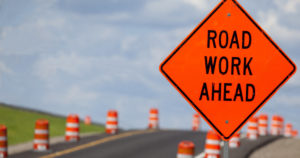Pennsylvania Workers Sustain High Rate of Fatal Work Zone Injuries
January 7, 2021 According to data from the Bureau of Labor Statistics (BLS), an average of 123 construction workers die – and thousands more sustain serious injuries – in collisions that happen on active road construction sites each year. Certain states incur a greater number of annual work zone deaths than others. For example, Pennsylvania ranks as the state with the third-highest rate of work zone fatalities. By increasing effective injury prevention measures, such as installing traffic control devices and enforcing work zone speed limits, both employers and local governments do their part to keep workers safe.
According to data from the Bureau of Labor Statistics (BLS), an average of 123 construction workers die – and thousands more sustain serious injuries – in collisions that happen on active road construction sites each year. Certain states incur a greater number of annual work zone deaths than others. For example, Pennsylvania ranks as the state with the third-highest rate of work zone fatalities. By increasing effective injury prevention measures, such as installing traffic control devices and enforcing work zone speed limits, both employers and local governments do their part to keep workers safe.
Work Zone Dangers
Roadway construction workers are not the only ones to face work zone-related dangers; so do drivers and passengers. The o reported more than 4,400 deaths and 200,000 injuries over a five-year period in active work zones across the country. Unlike motorists, however, highway workers do not have the added benefit of being inside a vehicle and wearing a seat belt.
The National Institute for Occupational Safety and Health (NIOSH) reports that some of the most common risks that workers on road construction sites are exposed to include:
- Flaggers and other on-foot workers are in close proximity to passing vehicles and construction equipment, which puts them at risk for major bodily injury
- Workers who operate heavy machinery or construction vehicles risk injury due to collision, overturn, or from being caught in between moving parts
- All highway workers face risks associated with poor visibility, inclement weather, poor lighting, and may work in areas with high levels of traffic congestion and drivers traveling at fast speeds
Tips for Preventing Accidents
It is clear that the majority of injury risks that work zone employees experience result from exposure to construction vehicles and the movement of passing motor vehicles. This is why it is so important to have safeguards in place that can protect workers from known job-related risks and limit injury and fatality rates. Per the Occupational Safety and Health Administration’s (OSHA) guidelines, employers are required to implement the following control measures to mitigate the hazards of working in active highway roadwork zones:
- Traffic controls such as cones, concrete, sand, barriers, crash cushions, delineator posts, and barrels. These control methods can help limit motorist intrusions into work zones
- Signage that alerts drivers that they are entering an active work zone and instructs them to follow paths away from where work is being done
- Flaggers should wear high visibility, fluorescent clothing made from reflective material. Employers must ensure that they provide workers with garments marked with performance class 2 or 3, which makes them visible at distances up to 1,000 feet. Flagger stations should also be illuminated
- Provide adequate lighting for workers on foot and construction equipment operators
- Seat belts and rollover protection should be used on all construction vehicles and equipment per manufacturer guidelines
- Ensure that flaggers are trained and certified on authorized signaling methods
Safe Driving in Work Zones
Employers have the responsibility to provide a safe and healthful workplace. Part of this responsibility mandates that employers ensure that the workplace is free from serious recognizable hazards and to comply with federal rules, regulations, and standards that are in place to keep workers safe. Some workers are unaware of the hazards they are exposed to. This is why it is so critical that employers not only value but also prioritize the health and safety of employees.
The responsibility for the safety of workers in active highway work zones does not fall solely on their employers, but also on motor vehicle drivers. Automobile drivers and truckers alike should observe certain safety tips to prevent catastrophic roadway accidents from happening. The Pennsylvania Department of Transportation, or PennDOT, recommends:
- Staying alert and paying attention to flaggers and signs
- Obeying posted work zone speed limits
- Avoiding all distractions and giving your full attention to the road
- Maintaining a safe distance around other vehicles
- Turn on headlights if signs instruct you to do so
- Using four-way flashers when stopped or traveling slowly
If a driver hits a worker in a work zone, the worker has the right to sue the driver for his or her injuries. Filing a third-party claim, which is a type of legal claim that holds the at-fault driver responsible for covering the damages they caused, is a complicated legal process. For example, if a truck driver hits a worker an experienced attorney may be able to prove that not only is the driver responsible for the worker’s injuries but also the trucking company and/or the people who loaded and/or inspected the truck. An attorney can examine the accident from every angle and assist in determining liability and fault.
If you were injured while working in a highway work zone and would like to learn more about filing a workers’ compensation or personal injury claim or have another legal question, someone at our firm can help. Contact a representative online now.
Philadelphia Workers’ Compensation Lawyers at Galfand Berger, LLP Representing Injured Individuals Since 1947
Galfand Berger, LLP has offices located in Philadelphia, Bethlehem, Reading and Lancaster, we serve clients throughout ha and New Jersey. To schedule a consultation, call us at 800-222-8792 or complete our online contact form.
 Google Screened
Google Screened
